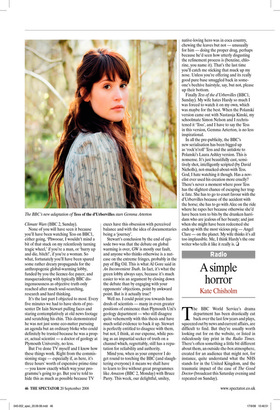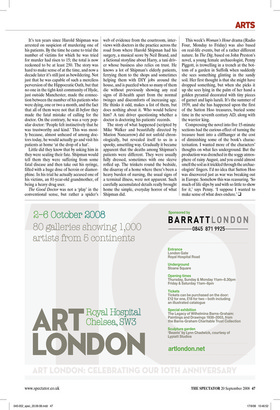A simple horror
Kate Chisholm
The BBC World Service’s drama department has been drastically cut back over the last few years and plays, squeezed out by news and current affairs, are difficult to find. But they’re usually worth looking out for on the website, or listed in ridiculously tiny print in the Radio Times. There’s often something a little bit different about them, an outside-the-box atmosphere, created for an audience that might not, for instance, quite understand what the NHS stands for in the United Kingdom, and the traumatic impact of the case of The Good Doctor (broadcast this Saturday evening and repeated on Sunday). It’s ten years since Harold Shipman was arrested on suspicion of murdering one of his patients. By the time he came to trial the number of victims for which he was tried for murder had risen to 15; the total is now reckoned to be at least 250. The story was hard to make sense of at the time, and now a decade later it’s still just as bewildering. Not just that he was capable of such a merciless perversion of the Hippocratic Oath, but that no one in the tight-knit community of Hyde, just outside Manchester, made the connection between the number of his patients who were dying, one or two a month, and the fact that all of them were not that ill before they made the fatal mistake of calling for the doctor. On the contrary, he was a very popular doctor: ‘People felt instinctively that he was trustworthy and kind.’ This was mostly because, almost unheard of among doctors today, he would actually go and visit his patients at home ‘at the drop of a hat’.
Little did they know that by asking him in they were sealing their fate. Shipman would tell them they were suffering from some fatal disease and then take out his syringe, filled with a huge dose of heroin or diamorphine. In his trial he actually accused one of his victims, an 81-year-old grandmother, of being a heavy drug user.
The Good Doctor was not a ‘play’ in the conventional sense, but rather a spider’s web of evidence from the courtroom, interviews with doctors in the practice across the road from where Harold Shipman had his surgery, a musical score by Neil Brand, and a fictional storyline about Harry, a taxi driver whose business also relies on trust. He knows a lot of Shipman’s elderly patients, ferrying them to the shops and sometimes helping them with DIY jobs around the house, and is puzzled when so many of them die without previously showing any real signs of ill-health apart from the normal twinges and discomforts of increasing age. He thinks it odd, makes a list of them, but does nothing about it. Who would believe him? A taxi driver questioning whether a doctor is doctoring his patients’ records.
The story of what happened (scripted by Mike Walker and beautifully directed by Marion Nancarrow) did not unfold chronologically, but revealed itself to us in a spooky, unsettling way. Gradually it became apparent that the deaths among Shipman’s patients were different. They were usually fully dressed, sometimes with one sleeve rolled up. The trinkets round the bedside, the disarray of a home where there’s been a heavy burden of nursing, the usual signs of a terminal illness, were not apparent. Such carefully accumulated details really brought home the simple, everyday horror of what Shipman did. This week’s Woman’s Hour drama (Radio Four, Monday to Friday) was also based on real-life events, but of a rather different nature. In The Dig, based on John Preston’s novel, a young female archaeologist, Penny Piggott, is trowelling in a trench at the bottom of a garden in Suffolk when suddenly she sees something glinting in the sandy soil. Her first thought is that she might have dropped something, but when she picks it up she sees lying in the palm of her hand a golden pyramid decorated with tiny pieces of garnet and lapis lazuli. It’s the summer of 1939, and she has happened upon the first of the Sutton Hoo treasures, buried some time in the seventh century AD, along with the warrior king.
Compressing the novel into five 15-minute sections had the curious effect of turning the treasure hunt into a cliffhanger at the cost of diminishing some of the book’s characterisation. I wanted more of the characters’ thoughts on what lies underground. But the production was drenched in the soggy atmosphere of rainy August, and you could almost smell the soil as it trickled through the archaeologists’ fingers. I’d no idea that Sutton Hoo was discovered just as war was breaking out in Europe. Somehow this was reassuring. ‘So much of life slips by and with so little to show for it,’ says Penny. ‘I suppose I wanted to make sense of what does endure.’ ❑











































































 Previous page
Previous page